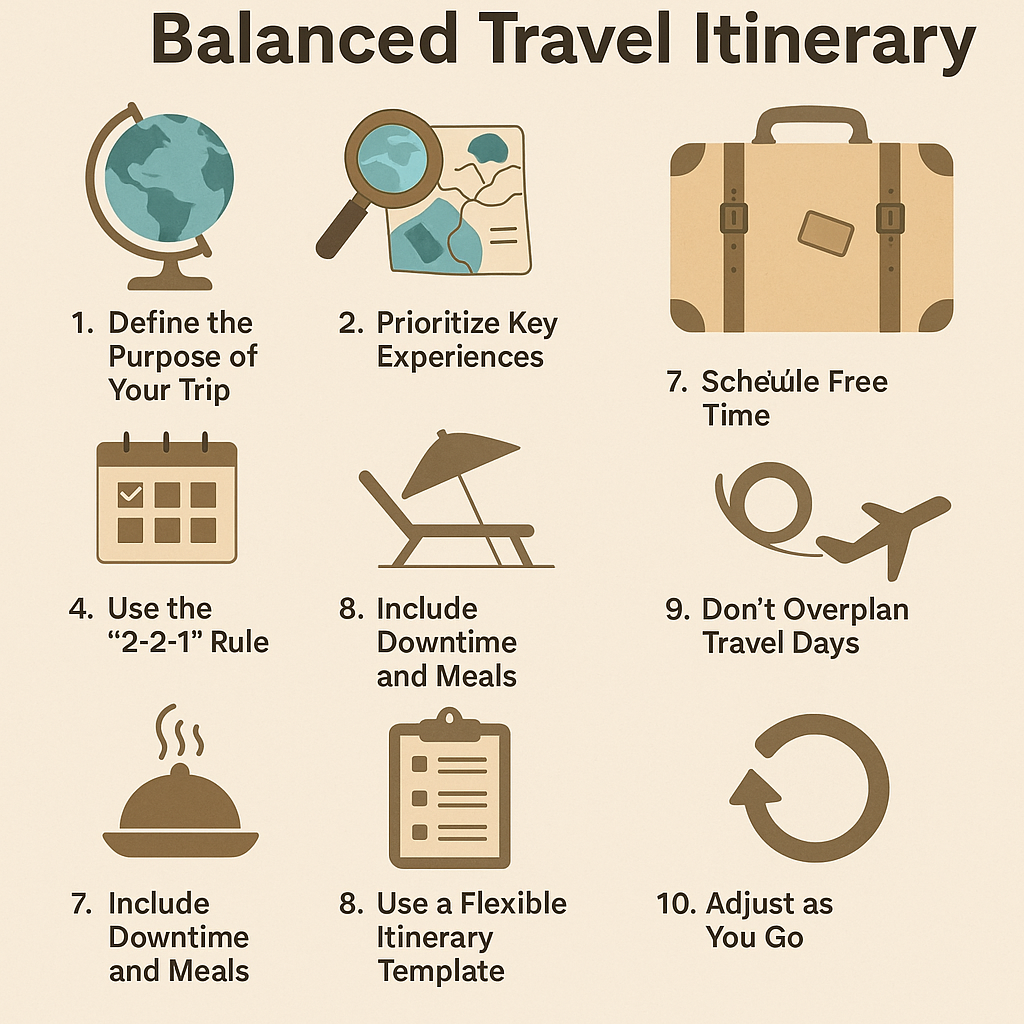Planning a trip is exciting, but it’s easy to fall into the trap of cramming too many activities into each day. A rushed itinerary can leave you exhausted and unable to enjoy the experiences you’ve traveled so far to have. A well-balanced itinerary helps you maximize your time while still allowing for spontaneity and rest. Here’s how to create a trip plan that works for your pace, preferences, and travel goals.
Why a Balanced Itinerary Matters
When traveling, you want to experience as much as possible—but burnout is real. A balanced itinerary ensures you:
- Have time to explore without rushing
- Can handle unexpected delays or changes
- Avoid decision fatigue during your trip
- Return home refreshed instead of drained
The key is finding the right rhythm: structure paired with flexibility.
Step 1: Define the Purpose of Your Trip
Every traveler has a different focus. Are you traveling for:
- Relaxation?
- Adventure and exploration?
- Culture and history?
- Food and drink?
- Photography?
- A mix of everything?
Tip: Let your travel purpose guide your daily pace and priorities. If your goal is relaxation, you’ll want more free time. If you’re all about sightseeing, your days may be fuller.
Step 2: Research Your Destination Thoroughly
Before you start drafting your itinerary, learn about your destination:
- Top attractions: What are the must-see sights?
- Opening hours: Many museums and sites close one day a week.
- Local holidays or events: These may affect schedules or offer unique experiences.
- Transportation logistics: How long does it take to get from point A to B?
Use tools like Google Maps, TripAdvisor, travel blogs, and tourism board websites for up-to-date info.
Step 3: Prioritize Key Experiences
Start your itinerary with your “non-negotiables”—the things you absolutely don’t want to miss.
Ask yourself:
- What attractions or experiences are the most important to me?
- Are there any tours or timed entries that require advance booking?
- What’s unique about this destination that I can’t get elsewhere?
Book time-sensitive activities in advance, such as guided tours, museum entry times, or adventure excursions.
Step 4: Use the “2-2-1” Rule
A helpful framework for balanced days is the 2-2-1 rule:
- 2 major activities (e.g., museum, guided tour)
- 2 smaller experiences (e.g., local market, café visit)
- 1 moment of rest or flexibility
This keeps your days full but manageable.
Step 5: Group Activities by Location
Avoid wasting time in transit by grouping attractions in the same area.
Example:
If you’re visiting Rome, you can plan to see the Colosseum, Roman Forum, and Palatine Hill on the same day—they’re all in the same area.
Use maps to visualize your route and minimize backtracking.
Step 6: Schedule Free Time
Leave room for unexpected discoveries, local recommendations, or just relaxing.
Free time ideas:
- Wander through a local neighborhood
- Take a coffee break and people-watch
- Watch the sunset from a scenic spot
- Explore a park or market
Tip: Add 2–3 hours of buffer time per day, especially for travel days.
Step 7: Include Downtime and Meals
Don’t forget to schedule time for meals and rest. You’ll need to eat, and food is part of the travel experience!
- Make dinner reservations for popular spots.
- Use breakfast time for planning your day.
- Take an afternoon break or nap if needed.
A well-fed traveler is a happy traveler.
Step 8: Use a Flexible Itinerary Template
Whether on paper, in Google Docs, or using an app like Notion or TripIt, create a template that includes:
- Date and day of the week
- City/location
- Morning activity
- Afternoon activity
- Evening plans
- Restaurant suggestions
- Notes (tickets, dress codes, etc.)
Keep it digital for easy updates on the go.
Step 9: Don’t Overplan Travel Days
If your trip includes moving between cities or countries, make those days lighter.
- Avoid booking major attractions on travel days.
- Focus on check-in, meals, and a light walk to get familiar with your new location.
Tip: If traveling by plane or train, schedule time for delays, customs, and transportation to your accommodation.
Step 10: Adjust as You Go
Even the best itineraries may need tweaking. Be open to:
- Skipping something if you’re tired
- Swapping days if the weather changes
- Taking advantage of local tips or recommendations
A flexible mindset will keep your trip enjoyable even when things don’t go exactly as planned.
Sample Itinerary Layout
Here’s a simplified example for 1 day in Paris:
Monday
- Morning: Louvre Museum (pre-booked ticket)
- Lunch: Café de Flore
- Afternoon: Seine River walk + Notre-Dame
- Evening: Eiffel Tower visit (sunset view)
- Dinner: French bistro near the hotel
- Notes: Bring student ID for museum discount
Travel Better with a Balanced Plan
The best travel experiences happen when you feel both organized and free. By building a well-paced itinerary that balances adventure with rest, you’ll make the most of your journey and return home with memories—not stress.
Start with your top priorities, leave room to breathe, and enjoy the journey at your own rhythm.
